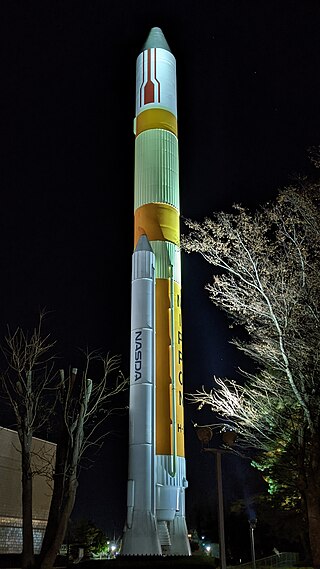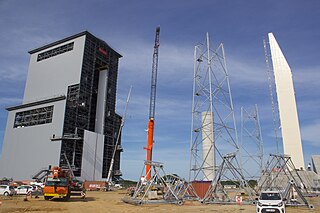Related Research Articles

Arianespace SA is a French company founded in 1980 as the world's first commercial launch service provider. It undertakes the operation and marketing of the Ariane programme. The company offers a number of different launch vehicles: the heavy-lift Ariane 5 for dual launches to geostationary transfer orbit, the Soyuz-2 as a medium-lift alternative, and the solid-fueled Vega for lighter payloads.

An expendable launch system is a launch vehicle that can be launched only once, after which its components are either destroyed during reentry or discarded in space. ELVs typically consist of several rocket stages that are discarded sequentially as their fuel is exhausted and the vehicle gains altitude and speed. As of 2022, most satellites and human spacecraft are currently launched on ELVs. ELVs are simpler in design than reusable launch systems and therefore may have a lower production cost. Furthermore, an ELV can use its entire fuel supply to accelerate its payload, offering greater payloads. ELVs are proven technology in widespread use for many decades.

The Guiana Space Centre, also called Europe's Spaceport, is a European spaceport to the northwest of Kourou in French Guiana, a region of France in South America. Kourou is located approximately 310 mi (500 km) north of the equator, at a latitude of 5°. In operation since 1968, it is a suitable location for a spaceport because of its equatorial location and open sea to the east.

Mitsubishi Heavy Industries, Ltd. is a Japanese multinational engineering, electrical equipment and electronics corporation headquartered in Tokyo, Japan. MHI is one of the core companies of the Mitsubishi Group and its automobile division is the predecessor of Mitsubishi Motors.

Sea Launch was a multinational—Norway, Russia, Ukraine, United States—spacecraft launch company founded in 1995 that provided orbital launch services from 1999–2014. The company used a mobile maritime launch platform for equatorial launches of commercial payloads on specialized Zenit-3SL rockets from a former mobile/floating oil drilling rig renamed Odyssey.

H-IIA (H-2A) is an active expendable launch system operated by Mitsubishi Heavy Industries (MHI) for the Japan Aerospace Exploration Agency. These liquid fuel rockets have been used to launch satellites into geostationary orbit; lunar orbiting spacecraft; Akatsuki, which studied the planet Venus; and the Emirates Mars Mission, which was launched to Mars in July 2020. Launches occur at the Tanegashima Space Center. The H-IIA first flew in 2001. As of December 2021, H-IIA rockets were launched 45 times, including 39 consecutive missions without a failure, dating back to 29 November 2003.
Spaceway-1 was a part of AT&T's constellation of direct broadcast satellites. The satellite was launched via a Zenit-3SL rocket from Sea Launch's Odyssey equatorial platform on 26 April 2005. Its operational position was in geosynchronous orbit 35,800 kilometres (22,200 mi) above the equator at 102.8° West longitude. Spaceway-1 was a Boeing 702-model satellite with a 12-year life expectancy. It provided high-definition television to DirecTV customers with its Ka-band communications payload. DirecTV did not make use of the broadband capabilities on Spaceway-1 even though it was originally built by Boeing for this purpose.
This is a list of the satellites operated by Optus, an Australian telecommunications company. The satellite communications facility is located at Belrose on Sydney's Northern Beaches. Optus' satellites are divided into 4 classes A, B, C and D. As of April 2014 it owns and operates Optus B3, Optus C1, Optus D1, Optus D2 and Optus D3. Optus A1, Optus A2, Optus A3 and Optus B1 satellites have been retired. Optus has the largest network of satellites in Australia and New Zealand.
Spaceway-3 is a communications satellite which was launched in August 2007. The third satellite in the Spaceway series, it includes a Ka-band communications payload. It is used by Hughes Network Systems to provide broadband Internet Protocol network service.

The H-II (H2) rocket was a Japanese satellite launch system, which flew seven times between 1994 and 1999, with five successes. It was developed by NASDA in order to give Japan a capability to launch larger satellites in the 1990s. It was the first two-stage liquid-fuelled rocket Japan made using only technologies developed domestically. It was superseded by the H-IIA rocket following reliability and cost issues.
JSAT Corporation (JSAT) was the first private Japanese satellite operator, which owned the JSAT satellites, as well as operated and partially owned the N-Star with NTT DoCoMo. Its origins can be traced to the funding of Japan Communications Satellite Company (JCSAT) and Satellite Japan Corporation in 1985. Both companies merged into Japan Satellite Systems Inc. in 1993. In 2000 the company was renamed as JSAT Corporation and was listed in the First Section of the Tokyo Stock Exchange. On September 1, 2008, the company was merged into the SKY Perfect JSAT Group.

This comparison of orbital launch systems lists the attributes of all individual rocket configurations designed to reach orbit. A first list contains rockets that are operational or in development as of 2022; a second list includes all retired rockets. For the simple list of all conventional launcher families, see: Comparison of orbital launchers families. For the list of predominantly solid-fueled orbital launch systems, see: Comparison of solid-fueled orbital launch systems.

ELA-3, is a launch pad and associated facilities at the Centre Spatial Guyanais in French Guiana. ELA-3 is operated by Arianespace as part of the expendable launch system for Ariane 5 launch vehicles. As of September 2022, 114 launches have been carried out from it, the first of which occurred on 4 June 1996.
A launch service provider (LSP) is a type of company which specialises in launching spacecraft. In 2018, the launch services sector accounted for $5.5 billion out of a total $344.5 billion "global space economy". It is responsible for the ordering, conversion or construction of the carrier rocket, assembly and stacking, payload integration, and ultimately conducting the launch itself. Some of these tasks may be delegated or sub-contracted to other companies. For example, United Launch Alliance has formally subcontracted the production of GEM solid rocket motors for their Delta II and Delta IV rockets to Alliant Techsystems, both vehicles are now retired. An LSP does not necessarily build all the rockets it launches.
Optus D3 is an Australian geostationary communications satellite, which is operated by Optus and provides communications services to Australasia. D3 was the third Optus-D satellite to be launched. It is a 2,401-kilogram (5,293 lb) satellite, which was constructed by Orbital Sciences Corporation based on the Star-2.4 satellite bus, with the same configuration as the earlier Optus D2 satellite.
The DirecTV satellite fleet is a group of communications satellites located at various geostationary orbits that DirecTV uses for their satellite television service and HughesNet internet service. The "DirecTV" prefix in their names has been changed to "T".

The year 2011 saw a number of significant events in spaceflight, including the retirement of NASA's Space Shuttle after its final flight in July 2011, and the launch of China's first space station module, Tiangong-1, in September. A total of 84 orbital launches were conducted over the course of the year, of which 78 were successful. Russia, China and the United States conducted the majority of the year's orbital launches, with 35, 19 and 18 launches respectively; 2011 marked the first year that China conducted more successful launches than the United States. Seven crewed missions were launched into orbit during 2011, carrying a total of 28 astronauts to the International Space Station. Additionally, the Zenit-3F and Long March 2F/G carrier rockets made their maiden flights in 2011, while the Delta II Heavy made its last.
Space launch market competition is the manifestation of market forces in the launch service provider business. In particular it is the trend of competitive dynamics among payload transport capabilities at diverse prices having a greater influence on launch purchasing than the traditional political considerations of country of manufacture or the national entity using, regulating or licensing the launch service.
The JSAT constellation is a communication and broadcasting satellite constellation formerly operated by JSAT Corporation and currently by SKY Perfect JSAT Group. It has become the most important commercial constellation in Japan, and fifth in the world. It has practically amalgamated all private satellite operators in Japan, with only B-SAT left as a local competitor.

ELA-4, is a launch pad and associated facilities at the Centre Spatial Guyanais in French Guiana located along the Route de l'Espace in the Roche Christine site, between ELA-3 and ELS launch facilities. The complex is composed of a launch pad with mobile gantry, an horizontal assembly building and a dedicated launch operations building. ELA-4 is operated by Arianespace as part of the Ariane 6 program. As of November 2022 the first launch is scheduled for the fourth quarter of 2023.
References
- ↑ "Mitsubishi Heavy Industries and Arianespace conclude MOU on cooperation in commercial space rocket launches". Arianespace. 7 June 2013. Retrieved 18 August 2014.
- 1 2 "MHI and Arianespace to Jointly Offer Satellite Launch Services". Mitsubishi Heavy Industries. 24 April 2007. Retrieved 18 August 2014.
- ↑ "No end in sight for satellite downturn". Flight International. 11 February 2003.
- ↑ "Boeing in Japanese alliance". Flight International. 22 June 2001.
- ↑ "Arianespace's operational motto: "Any mass, any orbit, any time"". Arianespace. 15 September 2004. Retrieved 18 August 2014.
Arianespace also was a moving force behind the creation of the Launch Services Alliance - a powerful commercial service offering that combines the strength of three leading launch service providers to ensure on time missions for customers around the world. The Launch Services Alliance provides mission assurance by enabling payloads to be switched if necessary between Ariane 5, the Boeing Sea Launch vehicle and Mitsubishi Heavy Industries' H-IIA.
- 1 2 "The Launch Services Alliance takes the spotlight in Washington, D.C. during its first news conference". Arianespace. 22 March 2005. Retrieved 18 August 2014.
- ↑ Jonson, Nick (31 July 2003). "Boeing, Arianespace, MHI form space launch service alliance". Aviation Week.
- 1 2 "Arianespace: back on track". Flight International. 4 July 2006.
- ↑ "Companies sign deal for launch vehicle switch option". Flight International. 5 August 2003.
- ↑ "Arianespace provides mission assurance to DIRECTV". Arianespace. 30 October 2003. Retrieved 18 August 2014.
- ↑ "SPACE SYSTEMS/LORAL-BUILT DIRECTV 7S SATELLITE SUCCESSFULLY LAUNCHED". Loral Space & Communications. 4 May 2004. Retrieved 18 August 2014.
The DIRECTV 7S high power spot beam direct broadcast satellite, built by Space Systems/Loral (SS/L) for DIRECTV Inc., El Segundo, Calif., was successfully launched at 8:42 am EDT today. The satellite was sent into space on a Sea Launch Zenit-3SL rocket from the Odyssey Launch Platform, positioned on the equator in the Pacific Ocean.
- ↑ "Launch Services Alliance". sky-brokers.com. Retrieved 1 April 2020.
- ↑ "Optus D1 - Groundbreaking Contract". Arianespace. 19 May 2004. Retrieved 18 August 2014.
- ↑ "Arianespace, Mitsubishi Sign Commercial Launch Agreement". satellitetoday.com. 30 April 2007.
